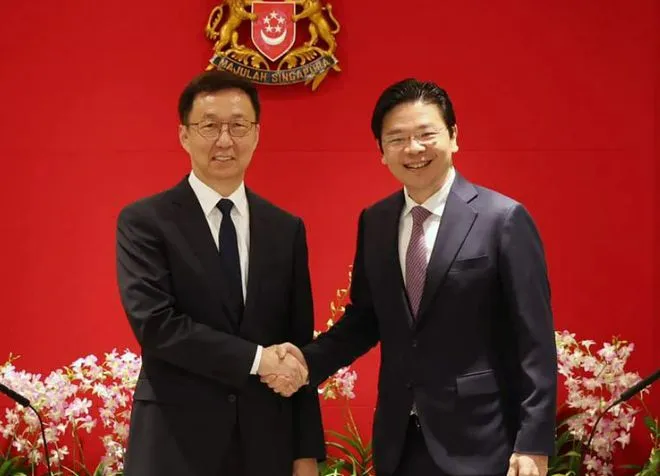腾讯、米哈游来坡疯狂招人,历史首次,新加坡成中国最大外资来源,签了19项合作
中国大厂来到新加坡发展,新加坡企业也去中国投资,一个良性的循环就这么达成了。
|1 min read

<p>这两天,中国高层到访新加坡,和新加坡政府官员进行了一系列的合作磋商,并<strong>签署了19项合作协议</strong>。</p> <p>而在此之前,不少中国知名大厂已经和新加坡有着深度合作。很多游戏公司,<strong>将他们“出海”的第一站设置在新加坡,</strong></p> <p>腾讯、米哈游、莉莉丝……众多游戏大厂,都把目光瞄准了新加坡。他们纷纷将这里当成是和世界交流的新舞台。</p> <p><img src="“https://i.imgur.com/2mWOJhQ.png“alt=““/"></p> <p>这些来自中国的游戏大厂来到新加坡后,在地化工作做得算是相当不错。</p> <p>选择新加坡,是这些中国知名大企业布局国际战略的重要一环。</p> <p><strong>这些游戏大厂选择新加坡:</strong></p> <p><strong>租下豪华办公室、疯狂招人中</strong></p> <p>这些中国大厂来到新加坡后,发展策略往往在细节上会有些出入。不过,疯狂招人,是不少中国游戏大厂目前正在进行的一项工作。</p> <p><strong>腾讯</strong></p> <p>来到新加坡的中国游戏大厂,腾讯绝对是名气最响亮的那一个。</p> <p>虽然遇到了一些非议,但在去年的一个排行榜中,腾讯游戏以320多亿美元的总收入,成为世界营收最高的游戏公司。</p> <p>并且远远拉开了索尼、微软等全世界知名游戏大厂,</p> <p><img src="“https://i.imgur.com/Nt7PVP7.png“alt=““/"></p> <p><strong>早在2016年</strong>,腾讯就开始在新加坡布局新业务并建立办公室当作区域性中心——旗下全资子公司PROXIMA。</p> <p>最终在去年,腾讯将一系列业务整合后,腾讯将PROXIMA合并成立了负责全球业务的Level Infinite,<strong>总部分为阿姆斯特丹和新加坡两处</strong>。</p> <p><img src="“https://i.imgur.com/7ilTdan.png“alt=““/"></p> <p>Level Infinite发行的游戏中,包括很火的《绝地求生》国际版</p> <p>腾讯甚至还特别为这个品牌制作了一个资料片,足以凸显出腾讯对此有多么上心。</p> <p>虽然相当低调,但多家媒体曾爆料,腾讯在新加坡租下的办公室,<strong>足足有1万多平方英尺之大,</strong></p> <p>办公室位于新加坡核心金融区莱佛士坊(Raffles Place)的华侨银行中心东大厦,据传这里的每个月的租金在11万新币左右,</p> <p>可以说,腾讯在新加坡是壕气满满很用心。</p> <p><img src="“https://i.imgur.com/xJweYWN.png“alt=““/"></p> <p>网上流传的腾讯新加坡办公室内部图,图源:Justco</p> <p>腾讯在新加坡花了大心思,不仅可以从其品牌宣发和超大办公室可以看出。</p> <p>近段时间,腾讯也在其官方招聘网站上,也开始了<strong>面对新加坡的新一轮大规模招聘工作。</strong></p> <p><img src="“https://i.imgur.com/JVQLxTf.png“alt=““/"></p> <p>在新加坡,腾讯开启的38个相关岗位招聘,包括3D模型工程师、游戏数据分析师等等,而且,<strong>有一半工作,都是在上个月才挂上网的新招聘</strong>,</p> <p>种种一切都在表明,腾讯对于“新加坡分部”的建设有多上心了。</p> <p><strong>米哈游</strong></p> <p>这几年,凭借着《原神》顺利出圈火爆全球的米哈游,在今年7月18日,正式启用了位于新加坡的办公室。</p> <p><img src="“https://i.imgur.com/tc2dFIh.png“alt=““/"> 图源:HoYoverse</p> <p>早在去年7月,米哈游就在新加坡成立了一间名为HOYOVERSE PTE. LTD的公司,并在今年重新命名为“Cognosphere”。</p> <p><img src="“https://i.imgur.com/oL2E32r.png“alt=““/"></p> <p>在新加坡地铁站内曾经随处可见的《原神》广告,图源:The Perfect Media</p> <p>现在,米哈游旗下的包括《原神》在内的多款游戏发行商已经改成了Cognosphere。而在HoYoverse的官网中,<strong>新加坡被介绍为公司全球化布局中“重要的一环”。</strong></p> <p><img src="“https://i.imgur.com/7njxwVJ.png“alt=““/"></p> <p>在新加坡,米哈游通过这间公司开启了社会招聘。不仅招收资深的用户分析师及工程师,就连刚刚毕业的学生,米哈游也“不想放过”。</p> <p><img src="“https://i.imgur.com/MgecYFD.png“alt=““/"></p> <p>当然,为了其全球化战略,HoYoverse大部分的岗位需求都是在搭建作为全球化枢纽平台的多方面细节。</p> <p>而新加坡的人才,似乎相当被米哈游看好。</p> <p>**莉莉丝<br> **</p> <p>另外一个在近期在新加坡开始布局的游戏大厂,是一些人可能不太熟悉的莉莉丝游戏。</p> <p>凭借着《万国觉醒》、《剑与远征》等游戏,在一些玩家群里中相当有人气的莉莉丝游戏,于今年4月25日成立了其全球游戏发行品牌Farlight Games。</p> <p><img src="“https://i.imgur.com/cbLsRRP.png“alt=““/"> 图源:Farlight Games</p> <p>这间公司的总部也位于新加坡。在官方文告中,莉莉丝对它的期望相当之高。</p> <p><img src="“https://i.imgur.com/shuv7gD.png“alt=““/"> <img src="“https://i.imgur.com/Hd12owP.png“alt=““/"></p> <p>不过,或许是因为业务需要,莉莉丝游戏并不像前面两个游戏大厂,在新加坡进行大规模招聘。</p> <p>截止到上个月10月26日,其招聘网站上新加坡地区只有9个岗位,且大多都是针对东南亚,印尼地区、越南地区一些游戏的营销推广岗位,以及游戏视觉设计和游戏产品运营岗位。</p> <p><img src="“https://i.imgur.com/e1vIXO9.png“alt=““/"></p> <p>寥寥无几的面向新加坡的招聘</p> <p>除了以上三个很多人熟知的中国游戏大厂外,像是IGG、游族YooZoo等有着中国背景的游戏公司,也早已将新加坡当作一个重要基地。</p> <p>像是IGG,更是在2009年就看到了优势,早早将公司总部扎根到了新加坡,</p> <p><img src="“https://i.imgur.com/c40kC72.png“alt=““/"></p> <p>可以说,这些年让游戏出海已成为中国游戏公司的共识。</p> <p>中国媒体曾经报道,包括中手游、三七互娱、创梦天地、吉比特、朝夕光年等公司均对外表示,将加大海外市场投入,制定相应计划面向海外市场。</p> <p><strong>从新加坡开始,逐步走向世界,似乎已经成为了很多中国游戏公司的共识。</strong></p> <p><img src="“https://i.imgur.com/lwHBABa.png“alt=““/"></p> <p>IGG的新加坡总部,图源:Glassdoor</p> <p>**新加坡的强大吸引力<br> **</p> <p><strong>不仅针对中国游戏公司</strong></p> <p>选择新加坡作为出海基地,其实并不是中国游戏公司的专属。</p> <p><strong>许多欧美互联网企业也将新加坡视为福地</strong>,Meta、Twitter、谷歌、亚马逊等全球知名企业均在新加坡设有办公处。</p> <p><img src="“https://i.imgur.com/iE9Cnxz.png“alt=““/"></p> <p>谷歌在新加坡的办公室,图源:Vulcan Post</p> <p>除游戏厂商外,<strong>中国的知名企业华为、阿里、字节跳动、爱奇艺等</strong>,也在新加坡设有办公室。</p> <p><img src="“https://i.imgur.com/IcjZcv6.png“alt=““/"> 图源:财新</p> <p>另外一个能表明新加坡有多热门的例子,是全球富豪的疯狂涌入。</p> <p>今年7月,全球知名的独立房地产顾问服务公司莱坊Knight Frank发布了一份《2022年财富报告》。</p> <p>报告显示,在2021年,新加坡3000万美元以上身家的超高净值人士,已经增加到4206人,比上一年增加了332人,</p> <p><img src="“https://i.imgur.com/46zTWf9.png“alt=““/"></p> <p>这其中,不仅仅有新加坡本地“孵化”获得成功的富豪,也有一些是获得成功后再入籍新加坡的人。</p> <p><img src="“https://i.imgur.com/pNSfhYe.png“alt=““/"></p> <p>新加坡和中国的良好关系,也让更多的新加坡资本去了中国,今年,<strong>新加坡已经成为了中国最大累计外资来源,</strong></p> <p><img src="“https://i.imgur.com/1SUVOUU.png“alt=““/"></p> <p>据他透露,新中两国的双边贸易额,今年更是<strong>有望突破1000亿美元</strong>(约等于1411亿新币),</p> <p>这一切早就有体现。在中国,来自新加坡的企业是越来越随处可见了,比如一开业就成为重庆市地标建筑之一的来福士广场,就是属于凯德置地的。</p> <p>而作为新加坡“国有”的投资机构——淡马锡,过去几年(除了2022年)的对华投资占比不断升高。</p> <p><strong>2020财年,中国市场在淡马锡的投资组合中甚至占比来到最大,</strong></p> <p><img src="“https://i.imgur.com/tDcMPT0.png“alt=““/"></p> <p>目前,新中双方还建立了三个政府间合作项目,分别是中新苏州工业园、中新天津生态城和中新(重庆)战略性互联互通示范项目。</p> <p>另外,广州知识城也已经在2018年,升级为国家级双边合作项目。</p> <p>新加坡积极加入由中国主导的“一带一路”倡议,新加坡与中国各省都建立了合作机制,双方的经贸往来,并没有随着疫情而中断。</p> <p>中国大厂来到新加坡发展,新加坡企业也去中国投资,一个良性的循环就这么达成了。</p>

